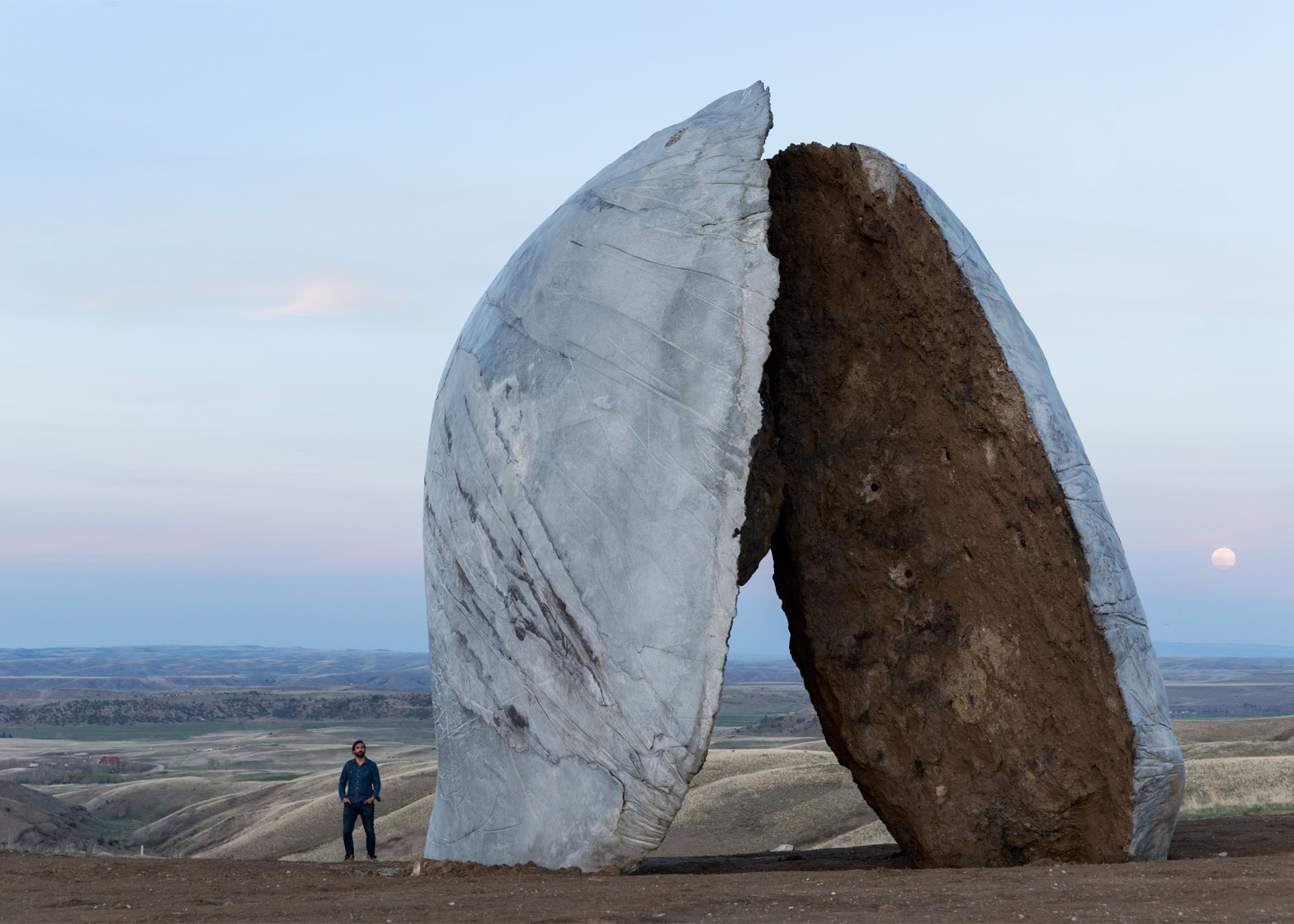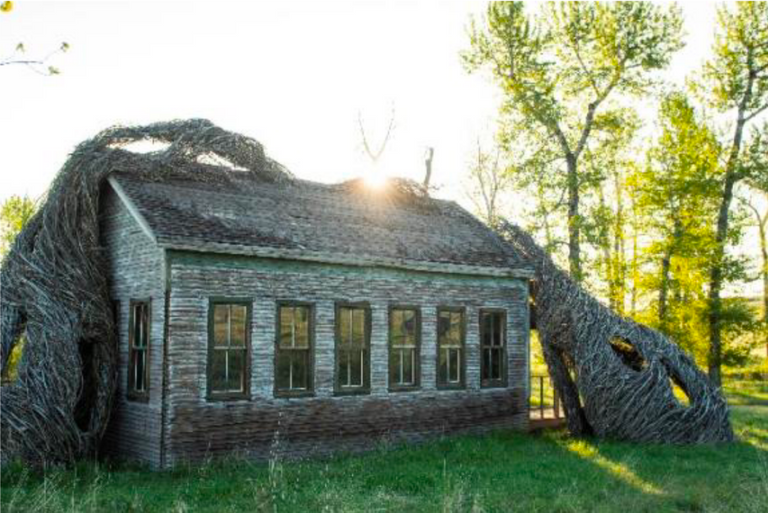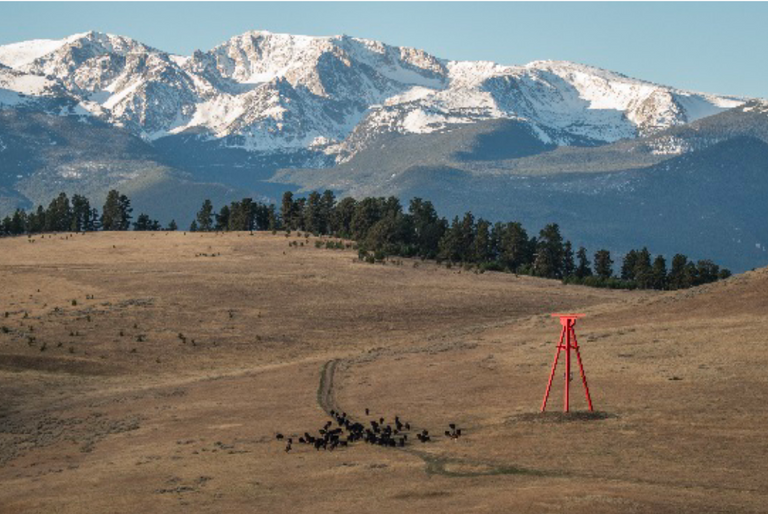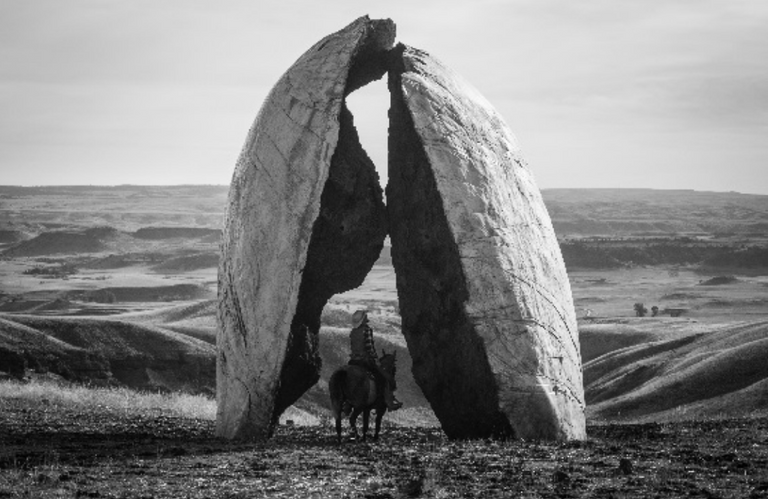Is Tippet Rise a Religious Experience?

Tippet Rise, Montana: where two wealthy artists have invested in making ecstatic experiences for others. Would you like to be surrounded by rugged mountains, transported from one large-scale contemporary artwork to another in a free, solar-powered van while they charge your phone for you? How about being driven around by a sweet Frenchman who waxes poetic about his life’s work in a dusty pick-up truck? How about some gourmet locally-sourced food and a concert pianist? And some cows? This week, we’ve got it all.
Tippet Rise online: https://tippetrise.org/
Tippet Rise on Instagram: https://www.instagram.com/tippet.rise/
This piece was inspired by an article by Rachel Syme: https://www.surfacemag.com/articles/tippet-rise-sculpture-park-montana/
Listen to the episode
Transcription of our visit to Tippet Rise
Abbreviations
SV: Svea Vikander
AB: Alban Bessuet
BF: Beth F.
PH: Peter Halstead
CF: Cathy Frank/Halstead
CO: Chris O’Reilly
__
[Dramatic piano music: “La Semaine Grasse”, performed by Jenny Chen]
AB: ...Oh absolutely. And, I mean the intensity, the investment of soul and mind and ideas and energy that went into this project is, I mean it feels like giving birth. I had the exact same feeling of embracing humanity as when, um, we gave birth to my first daughter. It was the exact same feeling I had.
[piano crescendo, applause]
SV: Most artists don't have much money and their work is small by necessity. It fits into storage lockers or on the walls of their buyers, to be sold at craft fairs. But every once in a while, an artist gets rich. Or people with a lot of money happen to be artists. When this happens, it's kind of amazing. Because when artists have money, they don't stop working, they don't retire early. They keep making their work. They just make it... Bigger.
That's what's happened at tippet rise. Tippet rise is an 11,000 acre sculpture park bordering millions of miles of parkland along the Beartooth mountain range of Montana. It's a non-profit but entirely privately funded; the people who run it are artists, designers, and musicians. They've got the kind of budget most arts workers can only dream of; and so they're doing big things.
Their centre opened in the summer of 2016. It contains monumental sculpture; work by Mark Disuvero, Alexander Calder, Dougherty, and others. It has an immense concert hall. It has a band shell. It has an artist residency building decorated in tasteful earth tones. It aims to join the ranks of storm king and the Chinati foundation, drawing visitors to experience looming, abstracted sculpture in a rugged natural landscape.
[car on gravel sounds]
[muffled dialogue] can I close this? Well, I dunno…
SV: After camping overnight in Yellowstone National Park, my husband and I paid a visit to the bison, and drove highways and side roads to get to Tippet Rise, which is in the small ranching community of fishtail, in Montana.
[car driving sounds] [room ambience sounds]
[muffled dialogue] ...Your tour guide today... / hi, I'm svea, / very nice to meet you, welcome to Tippet Rise
SV: The first person we meet on our arrival is the center director, Alban Bessuet. I spent a few hours with Alban, as he drove me from one sculpture to another. With his warm, understated manner and french accent, he is the epitome of an art world stereotype. And yet, he's also a man of contradictions.
He drives a beat-up pickup truck. He has two smart phones, one for international calls, but they are both falling apart. When I asked him about the possibility of a sculpture being defaced by graffiti on them, first, he gives me the official answer: that they're trying to educate the public, and each sculpture is monitored by a docent; but then he tells me the answer I didn't even realise I was fishing for. He tells me,
AB: Well if it's a nice graffiti, maybe for the better!
[piano music, building in intensity]
SV: And he takes me to see the sculptures – a spaceship-like wooden structure by Stephen Talasnik, a replica of a nearby one-room schoolhouse with whorls of vine structures growing inside it by Dougherty; and an immense metal piece by Mark Disuvero.
But the most striking piece is by Ensamble Studios. A heretofore unknown Spanish design duo (a couple) made this piece. It's called Beartooth Portal. It's huge,
[abrupt music cut; large blowing wind sounds]
But seems small under the Montana sky. It's two massive slabs of poured concrete leaning against each other like two halves of a clam shell. Sheltering from the wind beneath them, Alban explained to me how they had made the sculpture.
AB:…Poured concrete, and it captures the shape, shape of the land as a cast, as a print...
SV: Imagine scooping out two wide holes in the sand of a flat beach and then lining those holes with plastic bags and pouring wet sand inside. If this were very good sand, or if you were a very good sandcastle builder, you could eventually pick up those two slabs after they had dried and perhaps even lean them against each other. Now imagine that they are made of concrete; now imagine that they're on a mountain top. And now imagine that they weigh—
AB: half a million pounds. Half a million pounds, that's a lot of weight. So we had to bring some of the biggest cranes in Montana to tilt the structure. It was very much like a bridge structure—
SV: But wait – did you catch that? The biggest cranes in Montana? A bridge-like engineering project in this small, unincorporated town of fewer than 500 people? What will the neighbours think?
There are people who wouldn't want a Tippet Rise in their backyard. A branch of the project slated for Colorado had to be canceled after the neighbours voiced concern for environmental impact and noise. And here in Montana, one neighbour has promised to pick up a megaphone and sing that staple of town-hall meetings, Joni Mitchell's 'big yellow taxi' if she hears music from the concert hall, ever. The staff at tippet rise don't like to talk about this part, each one tells me that the neighbours have been surprisingly supportive.
I spoke with Beth F., a woman visiting the centre for the first time that day. And she says it's a bit of both.
BF: So, there's, it's funny because as we were driving here my husband said, well there's the neighbours I guess that have an issue with all the trucks, who live on the route that the trucks all drove into and out of day after day as they were constructing the place and then there's the other set of neighbours who weren't impacted by any of that and so there's this huge positive side and not, I wouldn't call it negative, they were just impacted.
SV: I used to live in the country and I can understand why people would be upset at having so much change brought into their lives. The people coming in to see Tippet Rise after all are not mostly from Montana; they're not ranchers. They don't know the land.
[mournful string music, uncomfortably long]
But one thing I noticed in my day at tippet rise was that the people working on the project in their own way do truly love the land.
CF: Montana is just its own beauty that's more raw and more enormous and just, you, absolutely, you know,
SV: That’s Cathy Frank.
CF: you know, who could forget this land?
SV: She and her husband Peter Halstead are the brains and the financing behind tippet rise. Both come from business and banking families; both are artists. They've been married for 36 years and they're the kind of couple who speaks in unison, who finish each other's sentences (though he finishes hers more than she finishes his) and when I ask them about this huge project, their newest art centre, they just want to talk about each other.
CF: We really just thought about all the incredible moving experiences, these actually astonishing experiences [[interruption from Peter: that we had had]] yeah exactly, and we really tried to put them, you know, in some way all together.
SV: I ask them to describe these magical experiences. Peter tells me two stories involving water – one, running through the sprinklers at Storm King in their 30s; and the other,
PH: one day we were at the Venetian Theatre and it was raining and so the Polish pianist, Ivo Pogorelić said, 'Why doesn't everybody come on stage and listen to me play because otherwise you're gonna get wet', which was very nice and there were only like 50 people there, maybe 70, so we all went on stage and he played his concert and it was the most magical experience we've ever had and we said, what if we did that all the time? What if we mandated that? [[interruption from Cathy: not the rain! (laughter)]]
CF: Well I have to say there were, probably there were many seeds, [[interruption from Peter: a birth]] exactly, and I, I was always in love with art and I always painted and I always drew and peter really always was in love with music and with writing [[interruption from Peter: and photography]]. And I always loved poetry and writing very much but really when we fell in love I fell in love with music. You know that came into my life and it became something that just added so tremendously to everything that I felt about the world.
PH: And when we fell in love I said now I have to become a good poet. Now I have to be worthy of Cathy, I have to write something that is worthy of this incredible feeling we have. So it really was very helpful. I'm not saying it happened instantly but you know over the next 30 years progress was made. (laughter) not everyone would agree. (laughter)
SV: So peter is a poet; and an enthusiastic one. He does a lot of the writing for Tippet Rise and in the program guide he describes music in this way
Actor reading Peter’s poetry:…Essay or a spreadsheet. This is similar to the music of the spheres where the celestial frequencies flow through us to produce special effects. We are the transistors of the heavens.
SV: This is some pretty enthusiastic stuff for an art institution. Especially when the rest of the art world is saying things like this.
Bojana Kunst: Capitalism and the notion of production of subjectivity comes from a philosopher Maurizio Lazaratto, who actually put…
SV: That’s Bojana Kunst, by the way. She's great, she's very smart. But I doubt she would have been as much fun to interview, at least not as much fun as Peter and Cathy. They're not into pushing your boundaries the way most of the art world wants to. They just want to make you feel ecstatic
PH: I went to school in New England and Cathy did too really and that's I guess the, the breeding ground of transcendentalism and Emmersonianism and Thoreau—Walden, Whitman, all of that and to me that kind of brisk morning, those variegated coloured hills struck me as the intellectual chrysalis of America and the values that I believe, values that we are in danger of losing in our country but the Northeast has closed down a bit it's not quite the open land that it was when I went to school and when we grew up there and so I think we were looking to find that same intellectual quality of open space somewhere else and so that's why why we looked to Montana because even Colorado the space we could see, so much space was going to developments and even though you could buy a ranch, even though you could buy a large ranch, in Colorado, you weren't entirely sure that the land around you wouldn't be a development in 10 years.
[string music coming in]
Whereas we found here the land was inexpensive enough and the way other people thought was similar to ours and nobody wanted to see a developments, they wanted to see the open plains, the open foothills, the big mountains, the big sky and so it was more simpatico with how we grew up.
CF: And the first time, you know, Peter got here first and he called me, he called me and he called me and he said I think you better come up here and seriously I came up and I could feel it in my cells
[strings rise dramatically]
SV: Chris O'Reilly is the music director at Tippet Rise.
CO: Peter and I studied with the same piano teacher, Russell Sherman in Boston many years ago.
SV: Chris is in charge of curating performances from musicians from all around the world.
[strings suddenly stop]
But he has also been doing a bit of the performing himself. He told me about a private concert he put on for the sculptor Mark Disuvero, who is in his eighties and has two pieces on the property.
CO: We brought a very old steinway that I found in Santa Monica out and I played the final Shubert b-flat piano sonata for him and I understand there
[raptor screech sound]
was a raptor of some sort careening in the background as I was playing for him, so in full gaze of the mountains and, apparently, the wildlife... It's unlike anything you could ever imagine I mean there really is no other place like this.
[piano interlude]
BF: …thinking how did I get here. It's David Byrne all over again, you know, how did I get this beautiful wife? What happened?
SV: At the end of the day, I feel the same. I reunite with my husband. He has spent the day exploring the grounds by himself. He spotted a baby rattlesnake sunning itself and, six times, was offered a ride in one of the centre's solar-powered vans. He always prefers to walk.
We join a hundred other people for a concert by Konstantin Lifschitz, the most talented pianist I have ever heard; and then sit down for our tippet rise dinner, a locally-sourced and organic quail prepared by what may have been a cordon bleu chef and served on a disposable plate that's not made out of styrofoam but out of a pressed palm frond. As I drink my good white wine in the gentle shadow of a monochromatic, purposefully-rusted barn building, I do feel like I've entered some alternative, aesthete heaven.
But I don't feel relaxed. I felt both ecstatically happy and, well, a little unmoored.
[pause]
I feel tired. Cranky. It was all just too much. Too much art, too much music; too much beauty, too much kindness. It's a lot to handle.
[short pause]
And apparently I'm not the only one.
AB: it’s, it's a lot of emotion for one human being, it became very much overwhelming for all of us.
[piano coda]






